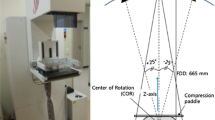Abstract
Digital breast tomosynthesis (DBT) is being investigated to overcome the obscuring effect of overlapping breast tissue in projection mammography. To quantify the effectiveness of DBT in reducing overlapping breast structures, it is important to investigate how breast structural noise propagates during the reconstruction process. Others have found that breast structure may be characterized as power law noise of the form κ/ f β. We investigate how the power law exponent, β, varies as a function of reconstruction methods. Clinical DBT data sets were used to analyze breast structural noise in both projection and reconstructed domains using different filter schemes of a filtered back projection (FBP) reconstruction algorithm. The dependence on filter settings was compared with cascaded linear system theory. The goal this work is to combine frequency domain analysis of breast structural noise with previous work on quantum noise in DBT and develop a generalized framework to optimize DBT for breast lesion detection.
Access this chapter
Tax calculation will be finalised at checkout
Purchases are for personal use only
Preview
Unable to display preview. Download preview PDF.
Similar content being viewed by others
References
Burgess, A.E.: Mammographic Structure: Data Preparation and Spatial Statistics Analysis. Med. Imag. 1999: Image Processing 3661, 642–653 (1999)
Metheany, K.G., Abbey, C.K., Packard, N., Boone, J.M.: Characterizing Anatomical Variability in Breast CT Images. Med. Phys. 35(10), 4685–4694 (2008)
Engstrom, E., Reiser, I., Nishikawa, R.: Comparison of Power Spectra for Tomosynthesis Projections and Reconstructed Images. Med. Phys. 36(5), 1753–1758 (2009)
Hu, Y.-H., Zhao, W.: Nonuniform Angular Dose Distribution in Digital Breast Tomosynthesis for Increased Conspicuity of Small High Contrast Objects. Med. Imag. 2009: Physics of Medical Imaging 7258, 72580Q1–72580Q8 (2009)
Mertelmeier, T., Orman, J., Haerer, W., Dudam, M.K.: Optimizing Filtered Backprojection Reconstruction for a Breast Tomosynthesis Prototype Device. Med. Imag. 2006: Physics of Medical Imaging 6142, 61420F1–61420F12 (2006)
Lauritsch, G., Harer, W.H.: A Theoretical Framework for Filtered Backprojection in Tomosynthesis. Med. Imag. 1998: Image Processing 3338, 1127–1137 (1998)
Ludwig, J., Mertelmeier, T., Kunze, H., Harer, W.: A Novel Approach for Filtered Backprojection in Tomosynthesis Based on Filtered Kernels Determined by Iterative Reconstruction Techniques. In: Krupinski, E.A. (ed.) IWDM 2008. LNCS, vol. 5116, pp. 612–620. Springer, Heidelberg (2008)
Dobbins, J.T., Ergun, D.L., Rutz, L., Hinshaw, D.A., Blume, H., Clark, D.C.: DQE (f) of Four Generations of Computed Radiography Acquisition Devices. Med. Phys. 22, 171–181 (1995)
Tward, D.J., Siewerdsen, J.H., Fahrig, R.A., Pineda, A.R.: Cascaded Systems Analysis of the 3D NEQ for Cone-Beam CT and Tomosynthesis. Med. Imag. 2008: Physics of Medical Imaging 6913, 69131S1–69141S12 (2008)
Author information
Authors and Affiliations
Editor information
Editors and Affiliations
Rights and permissions
Copyright information
© 2010 Springer-Verlag Berlin Heidelberg
About this paper
Cite this paper
Hu, YH., Masiar, M., Zhao, W. (2010). Breast Structural Noise in Digital Breast Tomosynthesis and Its Dependence on Reconstruction Methods. In: Martí, J., Oliver, A., Freixenet, J., Martí, R. (eds) Digital Mammography. IWDM 2010. Lecture Notes in Computer Science, vol 6136. Springer, Berlin, Heidelberg. https://doi.org/10.1007/978-3-642-13666-5_81
Download citation
DOI: https://doi.org/10.1007/978-3-642-13666-5_81
Publisher Name: Springer, Berlin, Heidelberg
Print ISBN: 978-3-642-13665-8
Online ISBN: 978-3-642-13666-5
eBook Packages: Computer ScienceComputer Science (R0)




